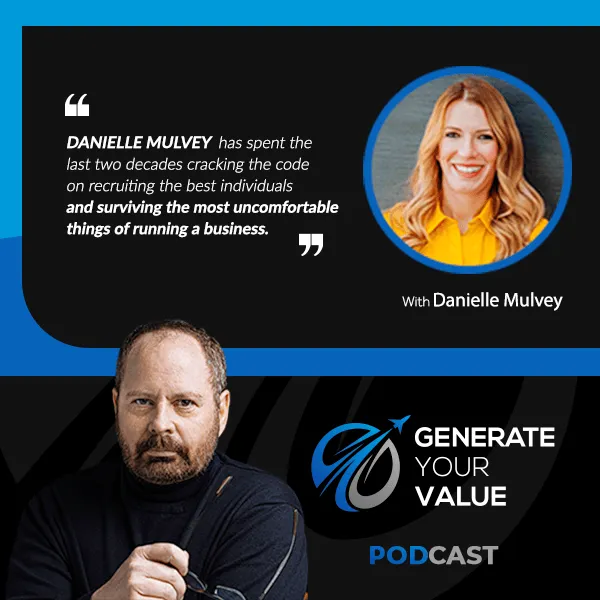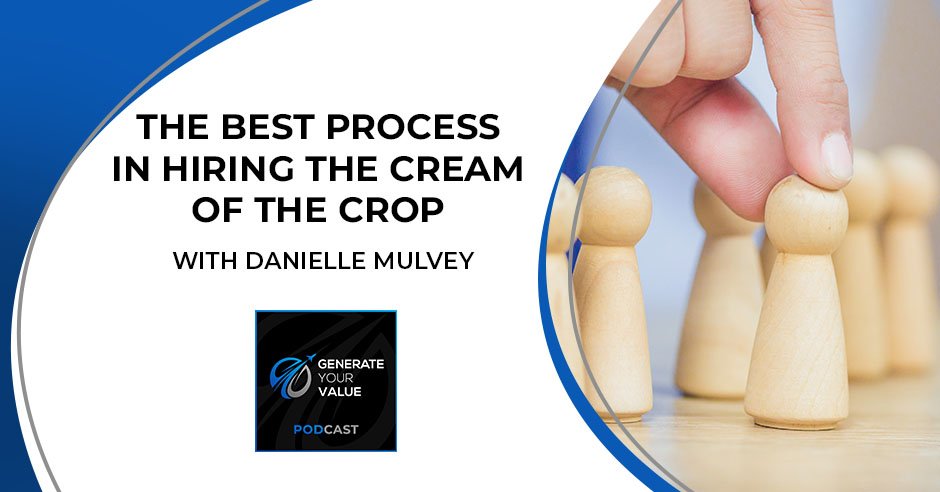Business owners often encounter a lot of bad hires, not necessarily because they have a bad leadership style. Most of the time, the cream of the crop eludes them due to their poor recruitment strategies. Danielle Mulvey addresses this business-killing problem by crafting an objective process that evaluates talent, not just new hires but existing employees as well. In this conversation with Andy McDowell, Danielle presents her Five-Star Rating System that can help businesses filter bad hires from desirable talents. She also explains the art of creating job description titles to attract applicants who will suit best to your available positions.
LISTEN TO THE PODCAST HERE
The Best Process In Hiring The Cream Of The Crop With Danielle Mulvey
LET’S START WITH THAT PUBLICIZED JOB DESCRIPTION TITLE
We have a very important topic for you. Some people love it. Some people hate it. It seems to me one of those topics where you’re falling in one camp or the other. That is the topic of employees. Some people call it human resources. Some people call it a pain in the rear end. We’re going to bring you a guest who is going to share with you her insights as to how you can find the cream of the crop or those employees that are going to be rockstars for you that are going to be engaged and home run hitters. You are a baseball team and you’re looking for those folks that hit home runs on a consistent basis. She’s going to help you find that.
Before I bring her on, let me give you her bio so you can understand a little bit about her story. We will get to that in the conversation as well. Danielle is a former flight attendant turned entrepreneur who has cracked a code on recruiting and retaining what she refers to as 5-star employees. What is a 5-star employee? They are game-changing, dedicated, and hardworking people who make big plays and get real consistent results. Never one to settle for average, Danielle has scaled her several companies to over $50 million in annual revenue while spending less than 10 hours each week overseeing their operations.
Danielle’s own team of trusted 5-star employees provides her with the freedom to spend the rest of her workweek guiding other entrepreneurs through podcasting, workshops, and community curating. In addition to running her companies and assisting other entrepreneurs, Danielle is the Chief Curator of The ALL IN Company community, which strategically advises other entrepreneurs on attracting and hiring 5-star employees.
She has been developing testing and sharing these ideas for more than 10 years now with a staggering 90% success rate. Danielle attributed her success to her undeniable gift to identify and nurture 5-Star Employees. She knows that in order to succeed, leaders need to get comfortable with the uncomfortable and go all-in on their employees who reciprocate and go all-in on the company. With that being said, Danielle, welcome to the show.
Thanks so much. I’m excited to be here.

When I go on other shows, I can’t remember if it was the opening sentence or the second sentence, my bio reads, “He thought of himself more as a life coach than a boss.” We’ll get into that later in the conversation. If you could give our audience the 2 to 3-minute Reader’s Digest version of how you got to where you are.
I was a flight attendant for the first year after I graduated. I call it my gap year after I graduated from Vanderbilt University. What’s interesting about that role was that I was doing it to buy myself some time and wait for my fifth-year senior boyfriend to graduate. What’s funny is that they should have never hired me as a flight attendant. My interview with American Airlines was four questions. The person interviewing me was like, “Should I ask you more questions? I have never had such a short interview. You got the job if you want it.” I was like, “I flew all the way from Orange County, California to Dallas, Texas to get asked 4 questions, talk to you for 5 minutes, and I get hired?”
If they would have spent a little bit more time with me, they might have not hired me as a flight attendant. I was a fine flight attendant. I was always on time. I did my job and such, but I wasn’t going to be a lifer at all. Thankfully, the hiring manager looked at my degree and asked me four questions and I was onto a short career as a flight attendant. That fast forwards me to a couple of years later, I started my first business in an advertising and marketing agency in Nashville at the ripe old age of 25. My hiring strategy for employees was to hire people younger than me because if I hire people younger than me, then they would have no experience with bosses who knew what they were doing.
Working for me, they will have no expectations. That strategy worked for a while. I was lucky with my first few hires, and then I made a bad hire. I distinctly remember this. I woke up on a Monday morning and said, “Can I call in sick to my own company?” I did not want to go in and face another week with this individual. He was horrible. He thought he was too cool for school. He had just graduated a few months prior from university. He just didn’t get it and was making everyone miserable.
That’s when I said, “I need to get serious about this recruiting and hiring employees. That was many years ago. For those years, I have been going deep and long on how to perfect and cracking the code on how to recruit, hire, and retain what I coined 5-star employees, the top 15% of available talent for the given rate.
You wanted to be the smartest one in the room. I’m assuming that you were equating the age thing to, “I have more experience because of my age. Therefore, I’m going to hire people that are younger than me.”
I had no idea what I was doing. I was an entrepreneur at 25. I was lucky that Nashville was a great entrepreneurial community. We were doing over $1 million in our first year of business and we were growing fast. Things were great on one side but I had no clue what I was doing, and so I defaulted to, “I’ll get people who won’t question me. I’ll get people who won’t tell me what to do because I don’t know what I’m doing.” Would I change it? I don’t know. Maybe.
The difficult times in my life were on the personal side and the business side. I have no regrets about it because it made me into the person I am now. I would be willing to bet you feel a little bit like that. In that respect, it puts you on a better path which is what life does to you. Let’s talk about your star system for a minute. Give our audience an idea of what that system is like and how you would grade an individual. In other words, if you met him and asked a certain set of questions, how do you figure out whether they’re a 1-star, 2-star, 3-star, 4-star or 5-star? Is there a bare minimum number that a person should hire?
A 5-star employee represents the top 15% of available talent for the role at a given rate. I’ll use myself as an example. I could get a job as a bookkeeper. No problem. I could get three offers in one day as a bookkeeper, but I would be a 2-star bookkeeper because I know enough to be dangerous. I would enjoy the job. It’s not my cup of tea, but I’m a 5-star entrepreneur.
Just because you’re a five-star employee for one role doesn’t mean you have the same rating on all roles.
Just because you’re a 5-star employee for one role doesn’t mean that you’re a 5-star employee for all roles. We see this a lot in people in business. When they take their top salesperson and they make them a sales manager, that 5-star salesperson doesn’t usually translate into becoming a 5-star sales manager. That’s probably an easy example for everyone who has experienced that and such.
It’s about getting specific about exactly what you need for the role because what you need for every role is different. When you go through the 5-star employee rating system, there are aspects to it where you customize it. The 5-star rating system is meant to be an objective process and system to consistently evaluate talent. You can use it on your existing employees and candidates coming in. It’s consistent and objective, and it’s a process and a system.
What I find is that most hiring managers are winging it. No one has ever told them or they’re like me, I never learned when I started my business how to recruit and hire the best employees. You got a candidate coming in. What do you do? You google the best interview questions to ask and you ask questions ad hoc. The 5-star employee rating system gives you discipline, a process, and a system. There are five criteria, obviously. We can dive into each of those.
The first criterion is core value alignment. Most entrepreneurs, business owners, and managers are like, “If I could just clone myself, then this would be fine.” Cloning yourself comes down to the DNA that is your core value. Your core values are those things that are true 100% of the time. When we take businesses and owners through our process, we take them through a core values exercise. There’s a big a-ha there because what they think as their company’s core values are group-think values or aspirational values, and not what their deep down, 100% true all the time core values.
That core value alignment is the secret to cloning yourself because that’s how people are going to behave and act when they are aligned and share your same core values. Think about personal relationships. Oftentimes, personal relationships, whether they be romantic or friendships, tend to disintegrate or break down when there is a conflict of core values and you’re not aligned with those core values. If that is a factor in your personal life, of course, you spend oftentimes more time with people that you work with. It’s important that the people that you work with have an alignment of core values.

The second star in the 5-star employee rating system is the 11 universal qualities of a 5-star employee. We have identified 11 universal qualities that are applicable to a 5-star employee, no matter the role. Out of those 11 qualities, 2 are coded green, which means they’re relatively easy to change, and 2 are coded red, which means they are difficult to change. If someone doesn’t meet your minimal acceptable rating for one of these qualities that are coded red, then that’s it. They’re done. They have filtered themselves out of your process. They won’t go forward because hiring a 5-star employee is about never settling. You don’t want to settle for less than a 5-star employee.
When these red flags show up or when someone doesn’t meet the criteria, they’re filtered out of the system because we want the top 15% of available talent. Only 1 out of 7 candidates is a potential 5-star employee. You’re going to be kissing a lot of frogs and you’re going be tossing a lot of frogs back into the pond because most of those people are going to be 1, 2, or 3-star candidates for the job, and we don’t want to settle for that.
Those two red qualities that are the big red flags are being limber and listening. Most small businesses need employees who are limber. These are people who are good with change. They can roll with the punches, cover someone’s shift, show up early, and stay late. We don’t like to use the word flexible. Employers need limber. Employees want flexibility. Those are two different expectations when you get down to it. We advise employers to use the word limber and let employees say, “I want flexibility,” because they are two separate things.
Listen is another one of those red qualities and a big red flag. You want someone who is an active listener. Someone who can pay attention, use all of their senses to know what’s going on, be able to process things, and get ahead of things. Maybe for the job, in terms of the role that you’re recruiting for, you need someone who scores a 4 out of 5 in terms of being a listener. For another role, you might have someone who is doing the same thing day in, day out, packing boxes, or whatever. They don’t need to be a listener, so you’re looking for someone who is a 2.
It’s not like you need a 5 in terms of a listener or every one of the qualities. It’s specific to the role. I was interviewing someone back and it was a screening interview. She had gotten through a couple of phases of our gauntlet. She scored 70% or higher on our initial assessment. In the screening interview, we were three minutes into the interview and she was not answering the questions that I was asking, like pretty simple warm-up questions.
I was like, “This is weird.” I tried to make her a little bit slower and simpler, like easier answers. She still wasn’t listening to the question and what I was saying. This role was going to require a five. This was the highest-rated quality for this particular role. At about the 5. 5-minute mark, I said, “I’m sorry. I don’t think this is going to be a right fit for us and you, so I want to give you back your time. Thank you so much and good luck with your job search.”
That was it because that red flag was right there and obvious at the get-go. I wasn’t going to settle. I wasn’t going to be polite, continue, and maybe try to think, “This could work out. Maybe this will get better.” By using an objective system and by following and trusting the process, you can filter out 6 out of 7, 1, 2, and 3-star candidates so that you don’t settle for less than that one 5-star candidate, but it’s a numbers game. You ideally want 21 applicants to net 3 potential 5-star candidates. The majority of applicants are not 5-star candidates for the role.
What strikes me in my career with Boeing is that I came into Boeing through an acquisition. Before Boeing acquired us, it was very much up to the hiring manager to decide on what questions to ask and do the interview process. Boeing brought some processes to the table where they forced you to ask the same questions of every candidate, much like what you were talking about.
As the hiring manager, you didn’t have a lot of input into what those questions were. They were geared more towards necessary skills and experiences, not any of the types of things that you were talking about in terms of core values. My last two questions when I would hire somebody were always going after passions, “What is it about the aviation industry that excites you?”
I was looking for potential engagements. Can I inspire this person and make it a happy experience that they want to get out of bed in the morning and fight traffic for half an hour to get to the office to come and do the job? If all you’re going to do is ask questions about experience, skillsets, and those types of things, it’s like checking boxes. You won’t find those 5-stars.
You’re exactly right. It’s a combination of mindset and skillset. Usually, it’s pretty easy to check the boxes on skillsets, but that’s where it becomes a mis-hire. They’re not that passionate about it. Here’s the funny thing about this whole dynamic of employers and candidates. The employer wants to fill the position as quickly as possible, and the employee has thrown their hat in the ring and wants to get the job no matter what because no one wants to feel rejected. Also, on the employer side, no one wants to be someone that’s rejecting someone.
The mindset is a funny dynamic here too when it comes to this. We have to be wanting to make this a great opportunity and the right fit for the candidate so that they get the job and they’ll be successful in the role. If they are successful in the role, they are going to be happy. They are going to do well. They are going to knock it out of the park. It is this weird thing because people who apply for the job want the job. They are not likely not going to say, “I don’t want this.” They are going to want to get as many offers as possible for whatever reason. They’re going to say they can do it.
It’s like I could get hired as a bookkeeper and no one would test me on it. I would say, “I host this podcast and I know bookkeeping. I know QuickBooks Online and QuickBooks test talk.” I could talk the talk. I could get the person interviewing me to check the boxes that I have the skillset, but most people aren’t testing for that.
That leads me to criteria number three, which is aptitudes and skills. We have identified almost 30 aptitudes. In that list of aptitudes, you want to identify 9 to 13 that would be applicable to the role, and then you want to customize questions based on exactly what you’re looking for and what you’re not looking for when it comes to those particular aptitudes. You then want to incorporate skills testing as well. Some of the aptitudes might be someone demonstrating something to you or it might be asking questions about that aptitude.
You also want to layer in skills testing to make sure that they’re not just saying that they are a bookkeeper. Anyone can say that they are a bookkeeper. You want them to prove that they got the skills to do the job. Another interesting thing is how oftentimes people get hired and then fake it until they make it or, “I just have to get my foot in the door, and then I can figure this out.” That’s usually not going to work unless that’s the expectation of the person hiring people. It’s important to test the aptitudes and skills for the particular role. They’re going to vary from role to role.
The fourth criterion is success metrics. You want to identify 3 to 5 key responsibilities for the role, and then you want to define what success looks like in each of those responsibilities by quantifying that success and putting a number, a dollar sign, or a percentage to how success will be measured for those 3 to 5 key responsibilities. These 3 to 5 key responsibilities should be driving and having an impact on company revenue. Many times, job descriptions and resumes are very subjective and vague. Excellent communicator, how do you measure excellence in communication?
I bet if we were to read someone’s white paper, you and I would score it differently because my expectations are going to be different from your expectations in terms of communication. It’s important that you quantify and you put a number, a dollar sign, or a percentage in terms of defining exactly what success looks like for those key responsibilities. A part of the magic of the 5-star employee rating system is that this process will allow you to attract 5-star candidates while also repelling the 1, 2, and 3-star candidates.

When you put it out there in your job posting, “Here are the 3 to 5 key responsibilities, and here is how we measure the success of each of these responsibilities,” a 5-star employee is going to be like, “Bring it on. I can do this. I can nail this. I like how they’re saying this. I want to be here.” The person who thinks that they want to get into that role but maybe doesn’t have the experience or the wherewithal is going to look at that and go, “That looks like they’re going to be pretty strict on me on that. I don’t know if I can meet that. I’m not going to apply here. I’ll go to 1,000 other job listings for a bookkeeper who aren’t going to measure my success.”
For clarification, with these particular qualities, is this more about the process of building job descriptions and measuring points for communication to the candidate about the job? Is there some set of questions or something that you’re asking in order to evaluate the candidate against a particular set of criteria?
As I mentioned, the 5-star employee rating system is for existing talents as well as new talents. You use this with your existing employees, and you use it with your recruitment and hiring process. When you bring on employees, as part of their review, you are continually using the 5-star employee rating system to make sure that they’re on point to being a 5-star employee or you’re working on opportunities to elevate them to the next level.
As I mentioned, just taking your best salesperson and making them a sales manager usually does not end up being successful because the aptitudes and skills of a sales manager are different from a salesperson. The 5-star employee rating system allows you to take an existing 5-star employee in the role that they are now and then look at what’s needed if they’re to ascend to a different role.
You can then help coach them on how to make it to that role because maybe there are 3 or 4 new aptitudes and 5 new skills that they need so you can work towards that. Having this process, system, discipline, and framework allow you to do things in a very intentional and methodical way that provides transparency. It gives you a playbook and a roadmap for how you can help your employees grow and coach them. The best part of being a business owner or a hiring manager is going all-in on my people.
If I go all-in on 10 employees, then I’m 10X-ing myself. Oftentimes, especially in businesses, when you don’t have the right people, the hiring manager or the owner gets stuck working in the business. They got people collecting a paycheck but they’re not leveraging them. They’re not multiplying their efforts because they’re having to do the work. When you go all-in on the right 5-star employees, you’re 2.5X-ing or 3X-ing yourself. I can tell you this. I could do most everything in our companies, but I’m not a 5-star employee at all of those things in our company.
If I can get the right 5-star person to be doing that, they’re doing it better than I could do it. That’s more than 2X-ing or 3X-ing my effort if I was doing that same job. When you’re not working in the business and you’re working on the business and you’re going all-in on your employees, that’s when you’re leveraging so much.
You’re using a lot of the language I use with my clients about working on and working in the business. One of my favorite pieces of advice I give my mentees back when I was at Boeing is to never be afraid to hire smarter people than yourself. At the end of the day, as a supervisor, manager, director, vice president, or whatever title you have as a leader, the number one thing you’re going to get graded on is results.
Your number one job is to lead and inspire your team for what results look like, AKA the messages you’re getting from above you as a leader as to what they’re looking for in terms of results out of a strategy or whatever it may be. That’s the end game. There are other things involved about the environment you need to create and so forth that are going to get the best out of your people. The reality is that it’s about results.
Find smarter people than yourself that are a good fit in the roles that can do better than you. You stay in a higher chance of success in getting the results that you’re looking for either as the owner of a business or your management, or if you’re in a corporate world, what your executive leadership is looking for.
If you can get that, you don’t need to worry about promotions, money, and all those other things. It’s going to come naturally because you’re creating the one thing that’s the most important to those above you, which is results. It’s that perspective. That’s why I always told them, “Don’t be afraid to hire smarter people than yourself.”
A lot of times fear gets involved and it’s like, “I have to be the smartest person in the room. I have to do all the work because I don’t want to be looked over in terms of promotion,” or whatever. You’re missing the point. The point is the results, and if you bring in the results, you’re going to be first in line to get a promotion.
That also segues into the fourth star, which is about having success metrics. What success looks like and quantifying that success for the 3 to 5 key responsibilities. The final and fifth star of the 5-star employee rating system is making sure that employee is at least 3X-ing or having a 3X impact on their payroll. Are they generating 3X? If you’re paying them $50,000 a year, are they having a $150,000 impact on the company? Ideally, if you’re getting to 3X, then I’m going to challenge you to go on 4X-ing that employee’s value on the company in what they are doing.
This helps you make sure that what the employees are doing is meaningful and producing results, and not just shuffling paper, biting time, or whatever. Everyone, especially during COVID, has had a greater appreciation for time away from work. The challenge is how we can be massively productive and not just go through the 40-hour workweek and whatever happened, happened. I clocked in for 40 hours.
There are some cool ways that you can do that. We do a couple of things within our different companies, depending upon the company and the situation. In one of our businesses, we process long-term care claims. People need to process 45 claims a day. If someone processes 60 claims in a day, then they can clock out for the rest of the day and we’ll pay them for an 8-hour day. That’s a great incentive to be as productive as possible and get it done in 6 hours and get paid for an 8-hour day.
With another one of our organizations, we have certain days off. We’re making sure that we’re getting things done leading up to that holiday. Halloween is a holiday in one of our companies, and then in another company, we call it a bonus holiday. If things are slow traditionally in our construction material supply business, or if we know that things slow down and such, then we say, “Let’s clock out at 12:00 today.” Our clients are basically done by 11:00 or 12:00 on these days as well, “Let’s clock out at 12:00 and we’ll pay you for a full day.”
We note this on their paycheck. We have a category. We got a vacation, sick time, or whatever. We also have a bonus holiday. Anytime we’re giving the team extra time off or a bonus holiday because our clients are not placing orders or whatever, it’s noted on their time cards. I challenge businesses to think smarter and figure out how they can do things. There are studies that say that people are only productive for 3.5 hours a day. Can you get the work done in 35 hours a week? Who made 40 hours? It’s the Parkinson’s Law. If you give yourself a lot of time, you’ll take all that time. If you give yourself a little bit of time, you’ll get it done in that little bit of time.
If you give yourself a lot of time to accomplish something, you take all that time. If you give yourself only little, you will get it done even with limited time.
We talked a lot about evaluating candidates and evaluating current employees and everything. We’re looking for that top 10% or 15% that’s out there. What can a company do to find and attract? It is a two-way street between the company and candidates or potential employees coming in. What can a company do to find and attract that 15% or 10%, the cream of the crop, so to speak?
You got to kill the vanilla job postings. Everyone out there who thinks they’re pretty clever by going to your competitors’ websites and career pages, copying and pasting their job postings, and making your own out of that is like, “Blah.” You sound like everyone else. You need to get specific, short, and intentional and start with a better job post title. This is where you can stand out and start that attraction factor.
If you’re hiring for a bookkeeper, you don’t say, “Full-time bookkeeper with flexible hours.” You say, “Small business bookkeeper with the heart of a teacher.” That’s going to attract the right candidate for a business that serves small businesses than saying, “Bookkeeper, full-time with flexible hours.” You want to put in some qualities of exactly what you’re looking for so that people who are scaling this are like, “My dad owned a small business. I love entrepreneurs. I love small businesses. I want to work here. I want to help businesses understand their numbers. I want to teach them. I want them to understand.” It starts with the job posting title and getting intentional and serious but creative about it.
I’m looking forward to a day when I come across a company that has a job description title of Chief Culture Officer.
That is coming.
That will tell me something about that company. If they take culture within a company seriously enough that they want somebody who’s watching, maintaining, and helping to create the vision for the culture that they want within the company, that’s the company I want to work for.
If you follow the 5-star employee rating system, you don’t need someone trying to force culture because it will naturally happen when everyone is aligned with their same core values to start.
I totally agree with you, but as to abridge, the company is seeking more as you’re transitioning and you’re trying to get a living culture within the company that’s encouraging and supporting, emotionally safe, and all of those things that’s going to bring out the best in people. You need somebody to nurture that at first, and then hopefully, they put themselves out of a job.
It’s interesting that you mentioned culture. There is someone I hired and I was like, “Why are you looking to leave your current position?” She said, “They talked about how great their culture was, and they sold me on their culture.” The reality is that it’s not that at all. You got to be careful about this aspirational culture and what you talk about. It doesn’t matter what you say. It matters what you do. What can you do in your business right now to make that culture a reality and not just talk about it and not make it aspirational? Sometimes companies get a little too crazy about trying to be too cool for school in what they say in their job postings and on their career sites. Make sure that it matches the reality.

It drives me crazy to see companies that have bonus programs for executives that don’t measure them on the values, culture, and things that you’re asking out of your employees, yet you’re not rating your executives on whether they model that or not.
Ironic, isn’t it?
It drives me crazy. I live in that environment. Don’t even get me started. What advice would you give to a small business owner that’s maybe somebody like me who’s a solo entrepreneur? They are at a stage now where they are seriously looking at getting into the hiring game and starting to hire their first employees. What might be some first steps or some things that they should be thinking about that maybe we haven’t even talked about yet?
If you looked at the 5-star employee rating system, it got specific and intentional about what you wanted. Business owners get frustrated with hires that aren’t meeting expectations, but then I’ll go back and say, “Did you set clear expectations?” This is the fourth criterion of the 3 to 5 key responsibilities, defining objectively and quantifying what success looks like for those 3 to 5 key responsibilities.
That’s where I would start if you were looking at hiring people. What do you need people to do in your organization that is going to have a 3X return on what you pay them and impact on your organization, then how will you measure success because that success will drive that return on payroll figures? That is where I would start. Think about what it is going to be to be successful.

If you look at most job postings, it’s so vague. If you’re hiring an assistant and that assistant is going to be responsible for social media and you’re going to say, “Create content and post,” is it creating one blog a week or one blog a month? Is it posting once a day, 3 times a day, or 5 times a month? What is going to impact the business? What is going to produce the results? What is going to give you that return on the payroll? Get very specific and intentional about it, and then be prepared to hold them accountable for it.
For the 5-star employee, if it’s doable, they’ll nail it. They’ll get it done. It needs to be just right or a Goldilocks. You don’t want to set something that’s too high. When we do reviews of employees and when we do their key responsibilities, a three is what they want. It’s meeting expectations. If they’re exceeding expectations too much, then maybe they’re in the wrong role. Maybe it’s time to move them on. They could be exceeding expectations in one category, but if they’re exceeding expectations in all the categories, they’re in the wrong role or they are the wrong metrics.
I have found in my coaching experience that people get so fearful of the interview process and finding the right candidate. They’re not putting in enough time, intention, and work before they even get to that stage like writing a great job description. I had one client who was in the remodeling and roofing business. She wanted to hire a salesperson for the roofing side of the business.
As a salesperson, I said, “Let’s take your job and split it in two from the perspective of you need some hard technical skills or somebody who knows something about roofing itself, shingles, and the different types of roofs that you can have. They can talk technically and intelligently in front of the customer about what their options are or what might be the price differences of each option and those types of things.”
That is the hard skills if you will. On the other side, you have soft skills, which is the sales process. Those are the core values you were talking about. It’s the ability to relate to a customer, have some empathy, and understand the process of selling in the very stages. Are you customer-focused? It’s all those types of things.
If you can break it down into that, then you start looking at the risk of hiring the wrong person. When you’re looking at qualifications, it’s like, “I’m willing to give in these areas in order to manage risk.” Do you want somebody with a lot of good technical skills that have never been in sales, or would you rather hire somebody that knows a lot about sales? Maybe they were selling in the pharmaceutical business or something of that nature that you can then train on all the technical aspects of roofing. Where do you think is the most risk? If you can’t find that perfect person that checks all the boxes on the hard skills and all the boxes on the soft skills, you keep looking.
You keep looking. You never settle. That’s the problem. You don’t compromise. They are out there. You got to cast as wide of a net as possible. You need to be specific. The interesting thing is that most people are casting a little net like the net I use to grab a goldfish out of a fishbowl. That is what most people are using to pick up candidates. You need one of those ginormous fishing nets that is gobbling up all of the fish in the sea in one swoop. Don’t just rely on the job boards.
I’m also not a fan of sponsored job boards. I don’t think you need to spend money on Indeed or LinkedIn and such. You need to do lots of different ways. I could spew out a list of twenty out-of-the-box recruitment strategies. It’s the sum of all things that work. It’s not one thing. If you do five things, then you’re going to get more candidates. If you only do 2 things, you’re going to get probably less than half the number of candidates that someone who is doing 5 things will get.
It’s almost like the lead generation process for sales.
It’s a numbers game.
I take my clients through the whole profit-loss, the connection to marketing, and the sales funnel. Depending on your sales success rate, how many leads or opportunities do you need to have? The more you need, it’s going to drive your marketing decisions about what marketing channels you need to get that many fish in your net per se with your success rate. It’s the same thing as trying to find those great candidates if you can think that way. If you’re only looking for the 10% or 15% and that’s all you’re going to accept, then you need to have a wide enough net that at least one of that 10% or 15% is going to hop into your net.
If you cast a wide net out of the gate when you’re starting to recruit for a position, it doesn’t mean that it’s going to take you eight months to find someone. If you only make one effort and that doesn’t prove anything and you slowly add additional efforts, now it might take you eight months because you spread it out over time.

You’re doing it serially instead of parallel.
We have taken some people through this process. I’m thinking about the people that went through our September cohort. They are a little bit overwhelmed right now with the number of candidates and such. In their process, we implemented our platform with them that has the candidate take an assessment out of the gate, and then that assessment is scored against the benchmark for the role.
The benchmark for the roles is different from company to company, role to role. We took two bookkeeping firms through, and their benchmarks for a bookkeeper doing the same function are different. When someone scores 70% or higher, then they move on in their process. Their next stage is having them take a skills test. If they pass the benchmark that’s 70% or higher for the role, then they pass the skills test for being a bookkeeper. They then move on to the screening interview process.
That saves a lot of time when you have some automated filters in your recruitment gauntlet or your hiring gauntlet so that you’re not wasting your time with non-qualified candidates and you’re not tempting yourself to settle. I said, “If they don’t take the assessment, do not look at their resume. If they scored less than 70%, do not click on that person.” I wish I could erase them from the system. When you make the process efficient, it makes it fun. It gamifies it, but it also saves you time.
It’s a lot of risks and a lot of money. How do you feel about leadership styles? If you are looking for the 10% or 15%, and you’re good at bringing them in, do you have a favorite leadership style or attributes of a great leader that can keep a 5-star around and engage in getting the results that they are looking for?
If everyone is aligned in core values, that’s a good place to start. The assessments that we use to score against the benchmark talk about ability and also focus on personality. What’s cool is that it also identifies what type of team type of person they are, and you use this at the end. There are nine team types. What’s cool about that is that we’re all different. I find that based on the role, if you have gone through this process, then the team type that this person shows up for is the right team type for doing the job and working with the team.
You can pull a report that says, “Such and such is a maverick, and Joey is a harmonizer, and here’s how you guys can communicate best with each other.” If the harmonizer is the leader, then this is how he is going to lead. This is how such and such is going to follow. The more we can get understanding, transparency, and expectations out on the table, the better it is. I recommend being forefront with everything like saying, “This is my style,” and making sure that people are okay with it. They can respect each other and can flex when need be. I’m the boss but I flex. Even though I’m the boss and I could run a dictatorship, I flex because that works best. If we all give a little bit and I go in, then my employees are going to go in too.
The more leaders can understand and be transparent with their employees, the better relationship they can have.
I have always been a firm believer in what’s often talked about in love relationships, but there’s something to be said for “love languages” within the business world.
We have a survey that creates an operations manual for each employee. What’s interesting about that part of the onboarding process is the person completing the survey. One of the questions on there is, “How do you like to be shown appreciated? What is your love language?” That knowledge, having that understanding, not having to figure it out, and being upfront about it is so valuable.
I have had people who are spending time together. It’s like, “It’s not my cup of tea but I’ll make an effort to meet Lily and Lizzie for coffee in the afternoon, even though we work remotely but we’re in a geographically similar area.” That’s me flexing because it’s like, “I’m going to do this for them because they are worth it to me and I want to show my appreciation. I’m going to show it in a way that they appreciate it. Where my girl likes money, that’s much easier. I can just drop a gift card in the mail to her at a little spiff.
It’s the same thing about relationships. You might be involved with a spouse who feels the most love from quality time. The easiest one for you to give might be gifts. Gifts are easy. That’s easy for me. I wish it was gifts but the reality is it’s quality time. You got to flex with something that doesn’t come as easy for you, but it gets so much more appreciated on the other side that it creates a great relationship when you’re able to do that.
It makes beautiful reciprocity. That’s why we’re The ALL IN Company because when you go all-in on your employees, your employees will go all-in on you, and they act like owners to a certain degree.
If you go all in on your employees, they will go all in on you as well, resulting in a beautiful reciprocity.
It becomes an exchange. I advise my clients that bringing somebody on board as an employee is an exchange. Instead of saying, “I’m on my high mighty mountain. I’m giving you an opportunity and you need to come to bear. It’s all about you and not about me.” No, it’s an exchange. What value are you bringing to that exchange?
As you said, are you all-in about the success of the employee? If you can bring that to the table, then the employee is going to come back and be all-in and bring their value in terms of skillsets, talents, time, and everything else that you need to get the results that you’re looking for. That’s when it becomes an all-in situation on both sides. It’s when you can see it as an exchange and something that you have to bring to the table outside of a salary in your title.
It’s a beautiful thing.
I could talk on and on with you about this stuff. Unfortunately, our time has come to an end and I want to be respectful of your time. As I told you in the green room, we always finish up our time with great guests like yourself with the same question because I love collecting all the answers and letting our audience hear all of them. That question is this. What do the words “generate your value” mean to you?
Generating my value is making sure that I am 3X-ing or 4X-ing what I’m doing and having an impact on others. Even with my own employees, generating value is making sure that my employees are set up for success and can be 3X-ing and 4X-ing their return on the payroll.
I totally agree. It goes back to that dialogue we had about the exchange, making sure that you’re bringing something of value to the table so that they can bring something to the table too, and you have an exchange. That creates a great relationship between the two of you. Danielle, if somebody is interested in what you’re doing business-wise, in your community, and those types of things, what’s the best way for somebody to find you and get ahold of you?
I know I gave 2, but I’ll give you all 11 qualities and a whole breakdown of the 5-star employee rating system with our guide, How to Hire 5-Star Employees. You can get that by texting “neversettle” to 411-321 and you will get the guide, How to Hire 5-star Employees, with the whole list of the 11 qualities and all the other great stuff.
Danielle, I’m grateful for you coming and spending time with us. Hopefully, the audience is walking away with what we call here on the show, golden nuggets of information, that you can turn around using your personal life or your business life from that perspective. If you find that somebody could use this information and this conversation in the same way that you are going to use it, please share it. Please like it with your network and your folks so that they can have the same impact that you have had through this conversation.
I greatly appreciate you spending time with us on the show. In the next episode, we’re going to have another great guest like Danielle on the show. I hope you have a great day, a great week, and a great holiday season that’s coming up. Keep generating your value in this world. Take care.
IMPORTANT LINKS
ABOUT DANIELLE MULVEY
 Danielle Mulvey is a former flight attendant-turned-entrepreneur
who has cracked the code on recruiting and retaining what she
refers to as “5-Star Employees”: game-changing, dedicated,
hardworking people who make big plays and get real,
consistent results. Never one to settle for average, Danielle has
scaled her several companies to over $50 million in annual
revenue while spending less than 10 hours each week
overseeing their operations. Danielle’s own team of trusted
5-Star Employees provides her with the freedom to spend the
rest of her workweek guiding other entrepreneurs through
podcasting, workshops, and community curating.
In addition to running her companies and assisting other
entrepreneurs, Danielle is the Chief Curator of The ALL IN
Company Community, which strategically advises other
entrepreneurs on attracting and hiring 5-Star Employees. She
has been developing, testing, and sharing these ideas for more
than 10 years now, with a staggering 90% success rate! Danielle
attributes this success to her undeniable gift to identify and
nurture 5-Star Employees. She knows that in order to succeed,
leaders need to get comfortable with the uncomfortable and
go all in on their employees, who will reciprocate and go all in
on the company.
That’s not all – Danielle also authored the book The Rapid Real™
Guide to The 5-Star Employee Rating System, and is currently
co-collaborating with Wall Street Journal best-selling author
Mike Michalowicz on a new book, to be released in Fall 2023,
tentatively titled ALL IN: How to Get Your Employees to Act Like
Owners. She also hosts the popular show Profit First Nation, the
official podcast for Profit First.
Danielle Mulvey is a former flight attendant-turned-entrepreneur
who has cracked the code on recruiting and retaining what she
refers to as “5-Star Employees”: game-changing, dedicated,
hardworking people who make big plays and get real,
consistent results. Never one to settle for average, Danielle has
scaled her several companies to over $50 million in annual
revenue while spending less than 10 hours each week
overseeing their operations. Danielle’s own team of trusted
5-Star Employees provides her with the freedom to spend the
rest of her workweek guiding other entrepreneurs through
podcasting, workshops, and community curating.
In addition to running her companies and assisting other
entrepreneurs, Danielle is the Chief Curator of The ALL IN
Company Community, which strategically advises other
entrepreneurs on attracting and hiring 5-Star Employees. She
has been developing, testing, and sharing these ideas for more
than 10 years now, with a staggering 90% success rate! Danielle
attributes this success to her undeniable gift to identify and
nurture 5-Star Employees. She knows that in order to succeed,
leaders need to get comfortable with the uncomfortable and
go all in on their employees, who will reciprocate and go all in
on the company.
That’s not all – Danielle also authored the book The Rapid Real™
Guide to The 5-Star Employee Rating System, and is currently
co-collaborating with Wall Street Journal best-selling author
Mike Michalowicz on a new book, to be released in Fall 2023,
tentatively titled ALL IN: How to Get Your Employees to Act Like
Owners. She also hosts the popular show Profit First Nation, the
official podcast for Profit First.







